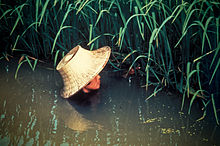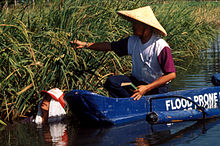- Deepwater rice
-
Deepwater rice is a variety of rice (Oryza sativa) grown in flooded conditions with water more than 50 cm (20 in) deep for at least a month.[1] More than 100 million people in South and Southeast Asia rely on deepwater rice for their sustenance.[2] Rice has adapted to deep water in two ways, known as traditional talls and floating rice. Traditional talls are varieties that are grown at water depths of between 50 cm (20 in) and 100 cm (39 in) and have developed to be taller and have longer leaves than standard rice. Floating rice grows in water deeper than 100 cm (39 in) through advanced elongation ability. This means when a field where rice is growing floods, accelerated growth in the internodal of the stem allows the plant to keep some of its foliage on top of the water. The Indica cultivar is the main type of deepwater rice, although varieties of Japonica have been found in Burma, Bangladesh and India.[3][4]
Contents
Production
Deepwater rice is a staple food that is grown on around 90,000 km2 (35,000 sq mi) of land. The main areas where it is grown are in South and Southeast Asia where more than 100 million people rely its production for their livelihood.[2] In South Asia the main area deepwater rice is grown in is the Ganges Brahmaputra basin in India and Bangladesh. In Southeast Asia the main areas of cultivation are in Burma in the Irrawaddy Delta, in Thailand in the Chao Phraya and Mekong in Vietnam and Cambodia.[5] In these countries deepwater rice account for more than 25% of the land used to grow rice.[2]
Deepwater rice is cultivated less in West Africa than in Asia with approximately 4,700 km2 (1,800 sq mi).[6] Areas it is grown include the Niger river basin.[5] Some areas in Ecuador grow deepwater rice.[7]
Cultivation methods
Deepwater rice is grown in tropical monsoon climates normally around river deltas and their floodplains mainly in backswamps and natural levees. The nature of the flood is important for success of deepwater rice, with timing and the rate of rise of water affecting survival and crop density. Generally, the flood water comes from rainfall or rises in the water table. In places with low rainfall, water overspilling from rivers can flood rice producing areas.
Issues
When seeds are sown directly into the ground the seeds and young plants can be damaged by drought conditions before floods arrive. During this stage the plants can also suffer due to competition from weeds. Sudden flooding, where a large volume of water enters the field in a short time, can lead to a high level of seedling death.[7]
Floating rice face additional problems due to the depth and time of the water it grows in. Water conditions such as turbulence and temperature can adversely affect the crop.[8]
Natural disasters can also damage or destroy deepwater rice crops. Tropical cyclones are particularly a problem in Asia. For example, in 2008 Cyclone Nargis damaged 122,782 hectares of deepwater rice in Burma.[9] If predicted sea level rises due to climate change happen, this would affect the pattern of flooding, causing deeper floods over a wider area and eroding the coast.
Characteristics
Deepwater rice is rice grown in flooded conditions with water more than 50 cm (20 in) deep for at least a month.[1] Rice has adapted to deep water in two ways known as traditional talls and floating rice. Traditional talls are varieties that are grown at water depths of between 50 cm (20 in) and 100 cm (39 in) and have developed to be taller and have longer leaves than standard rice. Floating rice grows in water deeper than 100 cm (39 in) through advanced elongation ability. When submerged this allows it to grow as fast as 25 cm (9.8 in) a day to reach a length of up to 7 m (23 ft) and survive in water as deep as 4 m (13 ft).[3][10]
The Indica cultivar is the main type of deepwater rice, although varieties of Japonica have been found in Burma, Bangladesh and India.[3][4] Deepwater rice emits the least methane, a greenhouse gas, of the wetland rice ecologies, producing approximately three times less than irrigated rice.
Floating rice adaptation
Floating rice is planted in dry ground and allowed to establish as young plants. The area becomes flooded which triggers the rice's elongation ability. This means when a field where rice is growing floods, accelerated growth in the internodes of the stem allows the plant to keep some of its foliage on top of the water. The stems are hollow and this allows gas to be exchanged between the plant and the atmosphere. Once the flooding ends the plant is left lying on the ground. The nodes at the top of the plant then start growing upwards towards due to gravitropic sensitivity.[3]
The elongation is triggered when the plant is submerged through a mechanism involving ethylene gas. Ethylene is normally produced by plants and diffused into the air but when floating rice is submerged in water this process is disrupted as the gas moves more slowly into water. This leads to a build up of ethylene in the plant. This triggers the production of a hormone called gibberellin which causes the rapid growth in the plant. When the plant reaches the surface the ethylene gas can escape as normal and the rapid growth stops.[10]
See also
References
- ^ a b Catling, p. 2.
- ^ a b c Bhuiyan, Sadiq I. (2004). Rice research and development in the flood-prone ecosystem. Int. Rice Res. Inst.. p. v. ISBN 9789712201974. http://books.google.com/books?id=raXqf7KomWYC&pg=PA73&dq=deep+water+rice&hl=en#v=onepage&q=deep%20water%20rice&f=false.
- ^ a b c d Hans, Kende; Esther van der Knaap, and Hyung-Taeg Cho (1998). "Deepwater Rice: A Model Plant to Study Stem Elongation". Michigan State University-Department of Energy Plant Research Laboratory. http://www.plantphysiol.org/cgi/content/full/118/4/1105. Retrieved 3 March 2011.
- ^ a b Catling, p. 110.
- ^ a b Catling, p. 7.
- ^ Prein, Mark; Madan M. Dey (2006). "Community-based fish Culture in Seasonal Floodplains". Penang, Malaysia: WorldFish Center. http://www.fao.org/docrep/009/a0444e/a0444e04.htm. Retrieved 7 March 2011.
- ^ a b De Datta, p. 244.
- ^ De Datta, p. 249.
- ^ "Water Buffaloes Needed in Cyclone-hit Burma, Says FAO". The Irrawaddy. June 19, 2008. http://www.irrawaddy.org/article.php?art_id=12835. Retrieved 3 March 2011.
- ^ a b Fountain, Henry (August 21, 2009). "In Some Rice Varieties, Genes Fuel Fast Growth When the Water Pours In". The New York Times. http://www.nytimes.com/2009/08/25/science/25obsnorkel.html. Retrieved 3 March 2011.
Bibliography
- Catling, David (1992). Rice in Deep Water. Int. Rice Res. Inst.book. ISBN 9789712200052. http://books.google.com/books?id=N5JxwKx1RAgC&pg=PA230.
- De Datta, Surajit K. (1981). Principles and Practices of Rice Production. Int. Rice Res. Inst.. ISBN 9780471097600. http://books.google.com/books?id=0odDhoWN7DIC&pg=PA244.
Categories:
Wikimedia Foundation. 2010.


